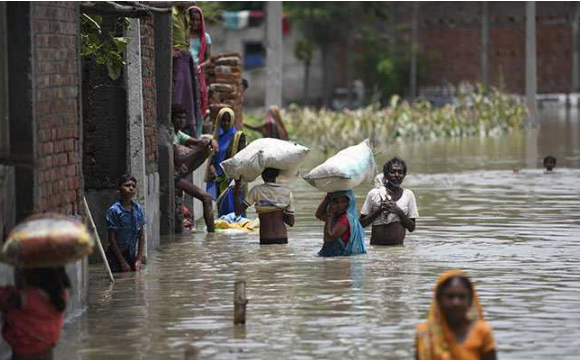Bihar: Fear of Waterborne Diseases Spreads in Flood-affected Districts, More Rain Expected

Image Courtesy: AFP
Patna: As floodwater started receding at few places in Bihar on Saturday, authorities feared the spread of waterborne diseases that may pose a new challenge for thousands of marooned and displaced people.
The water levels of major rivers, including Ganga, Koshi, Bagmati, Gandak, have been showing a declining trend, which is a respite from imminent flood threat. However, hundreds of villages remained submerged in knee-deep floodwater.
On the other hand, the flood situation remained grim in the Mithilanchal region of the state, with rivers flowing above the danger mark. Dozens of roads were also under knee-deep water in flood-affected districts, disrupting traffic.
Taking note of the situation, Bihar Chief Minister Nitish Kumar conducted an aerial survey to assess the flood situation on Saturday.
Large tracts of land continued to remain submerged due to flood water. There seems to be little chance of the water receding in the coming days, with the India Meteorological Department (IMD) forecasting more rains this week and later.
Taking serious note of a likely outbreak of diseases like Dengue fever, Diarrhoea, Chikungunya, Typhoid, Malaria, Gastroenteritis and skin infections, the state health department has alerted all civil surgeons and directed them to arrange essentials medicines at the government hospitals. "All the flood-affected districts and other districts have been alerted to deal with likely threat of disease following the water receding," a senior health official said.
According to health experts, fears of disease are growing in waterlogged or marooned villages and large tracts of land that remain submerged due to flood water.
All the district magistrates of flood-affected districts have been instructed to spray bleaching powder and distribute chlorine tablets. Besides, the district administration asked to create awareness about safe and clean drinking water in the flood-affected areas.
Bihar Disaster Management Department officials said that more than 37.39 lakh people in 15 districts had been affected by the floods. The most affected districts include Madhubani, Munger, Purnea, Supaul, Darbhanga, Saran, Bhojour, Samastipur, Vaishali, Katihar, Khagaria, Bhagalpur and Muzaffarpur.
To date, 26 people have officially died due to the floods in Bihar.
As per the Disaster Management Department's daily flood report, 2,570 villages under 93 blocks have been affected. Official data says that 1,41,704 people have been evacuated so far. About 75 flood relief camps and 960 community kitchens are running in the affected districts as well.
In 2019, after the floodwater receded, Patna alone reported more than 3,000 dengue and 1,500 Chikangunia cases. Similarly, disease outbreaks were reported in flood-affected areas in 2016, 2017, and 2018.
Dr Arshad of Patna-based Indira Gandhi Institute of Medical Science, said that waterlogging for days due to floods pollutes water in flood-affected districts that caused disease. "Threat of spread of disease like diarrhoea and typhoid increases due to polluted water in flood-affected areas," he said.
Mahendar Yadav, an activist working among the flood victims in Koshi region, told NewsClick, "Mosquito menace also increases manifold after floodwater begins receding. The mosquitoes cause the spread of malaria, dengue and other diseases."
Local reports say that thousands of people have been forced to flee their homes after their villages were inundated; they have taken shelter on higher ground, including embankments, under the open sky, on national highways, school buildings and government buildings. Many flood victims are also unable to arrange cattle feed, including green grass, due to an acute shortage of the same.
The officials of the Water Resources Department said the floodwater was still flowing on roads, including national and state highways in several districts.
The state has received surplus rainfall so far after the monsoon arrived on time in Bihar this year. Weather officials in Patna said the state received 784.7 millimetres of rainfall from June 1 to August 18, which is 18% above the normal rainfall received.
However, the IMD has forecasted more rains for this week and later.
Get the latest reports & analysis with people's perspective on Protests, movements & deep analytical videos, discussions of the current affairs in your Telegram app. Subscribe to NewsClick's Telegram channel & get Real-Time updates on stories, as they get published on our website.






















